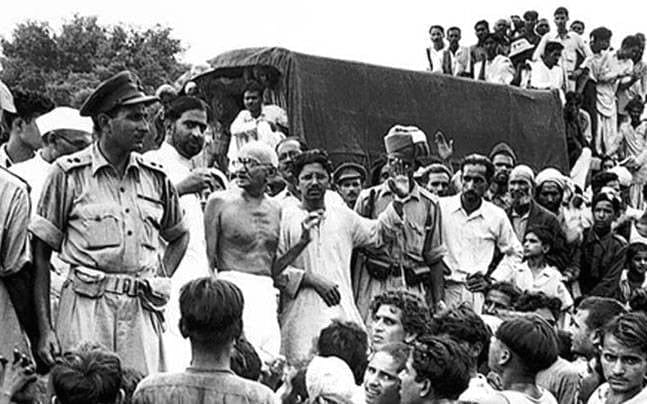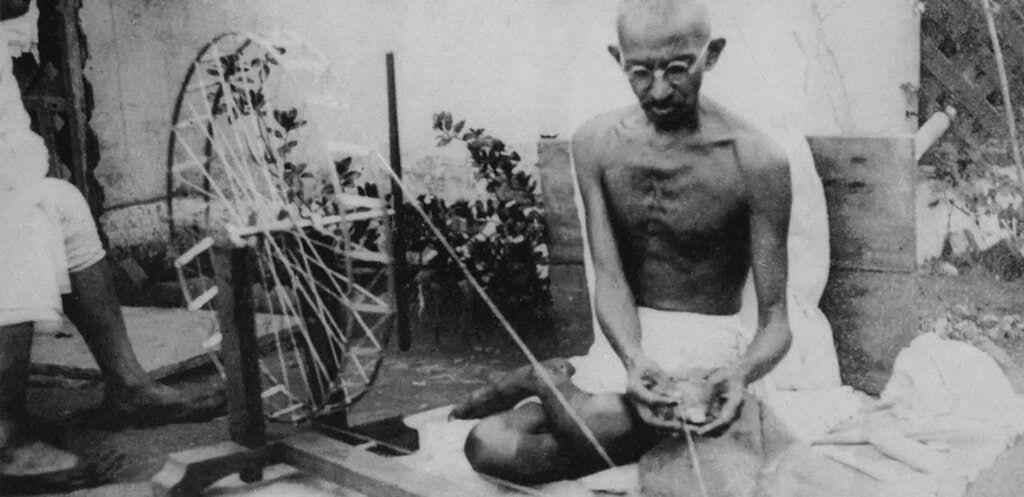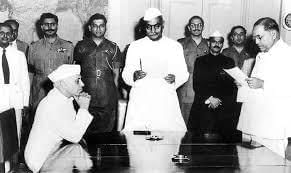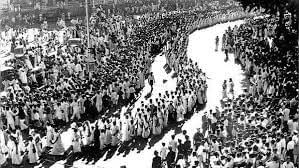Sure Shot Questions for Board Exams: Mahatma Gandhi & The Nationalist Movement | History Class 12 - Humanities/Arts PDF Download
Introduction
This chapter focuses on Mahatma Gandhi’s role in India’s freedom struggle, his philosophy of non-violence, and key movements like Non-Cooperation, Civil Disobedience, and Quit India. Below is a concise Q&A set to help you prepare for class tests, school exams, or board-level assessments with key, repetitive questions.
Key Questions
 View Answer
View Answer 
Lal-Bal-Pal refers to a trio of prominent nationalist leaders in India: Lala Lajpat Rai, Bal Gangadhar Tilak, and Bipin Chandra Pal. They were known for their assertive and radical approach to the freedom struggle against British rule. Key points about their contributions include:
- Advocated for Swadeshi (self-reliance) and protested against British policies.
- Transformed the freedom movement into a more radical mass movement.
- Played a crucial role in the anti-partition movement in Bengal.
- Used aggressive nationalist methods to oppose British rule.
- Called for swaraj (self-governance) and inspired the masses.
 View Answer
View Answer 
The Champaran Satyagraha of 1917 was a significant movement led by Gandhi, marking his first major effort in India. This movement aimed to address the struggles of indigo farmers in Bihar's Champaran district, who were forced to grow indigo under harsh conditions with little pay.
- Gandhi's intervention highlighted the oppressive practices imposed by British planters.
- His actions led to the formation of an inquiry by the British government.
- The exploitative teenkathia system was eventually abolished.
- Farmers received a reimbursement of 25% of their illegal rents.
This movement marked Gandhi's first successful mass mobilisation in India, establishing him as a key leader in the fight for farmers' rights.
 View Answer
View Answer 
Gandhi’s 1916 speech at Banaras Hindu University (BHU) was significant for several reasons:
- It publicly criticised the elite nature of Indian nationalism.
- Gandhi aimed to broaden the movement’s base to include the poor, such as labourers and farmers.
- He highlighted that nationalism had been dominated by lawyers, doctors, and landlords, often neglecting the majority of the population.
- This speech marked the first major statement of his strategy to transform the freedom struggle into a movement for the whole people.
- It foreshadowed the mass mobilisations of the 1920s, indicating a turning point in the nationalist movement.
 View Answer
View Answer 
The Rowlatt Act (1919), officially known as the Anarchical and Revolutionary Crimes Act, was a harsh law enacted by the British colonial government to suppress growing unrest after World War I. Key features of the Act included:
- Extension of wartime emergency measures, similar to the Defence of India Act.
- Empowerment of the government to arrest and detain suspects without trial.
- Political cases could be tried without a jury.
- Indefinite detention and severe restrictions on freedom of speech and the press.
This oppressive legislation sparked outrage across India, leading to widespread protests. It played a significant role in prompting Mahatma Gandhi to initiate the Non-Cooperation Movement, as it highlighted the need for a unified response against colonial rule.
 View Answer
View Answer 
The charkha (spinning wheel) was chosen as a symbol of the freedom movement for several reasons:
- Self-reliance: It represented the ideal of being self-sufficient and reducing dependence on foreign goods.
- Dignity of labour: Gandhi spun yarn daily, honouring manual work and promoting respect for all forms of labour.
- Economic independence: The charkha was affordable and accessible, encouraging small-scale village industries and empowering Indians to produce their own khadi instead of relying on British textiles.
- Social reform: It helped challenge the caste system by promoting the value of manual work, breaking down barriers between different types of labour.
The charkha symbolised a movement towards economic independence and social equality, making it a powerful emblem for the struggle against British rule.

 View Answer
View Answer 
The December 1929 Congress session in Lahore was a pivotal moment in India's struggle for independence. Key highlights include:
- Leadership Transition: Jawaharlal Nehru was elected as President, symbolising a shift towards younger leadership.
- Purna Swaraj: The Congress formally demanded complete independence from British rule, rejecting the idea of dominion status.
- Independence Day: 26 January 1930 was declared as Independence Day, encouraging nationwide celebrations with the hoisting of the national flag.
- Civil Disobedience: The session authorised civil disobedience, including tax refusals and resignations from legislative bodies.
This session not only set the goal of full freedom but also unified the masses, turning Independence Day into a significant symbol of the freedom struggle
 View Answer
View Answer 
The Gandhi–Irwin Pact, signed on 5 March 1931, was an agreement between Mahatma Gandhi and Viceroy Lord Irwin that temporarily halted the Salt Satyagraha and established a truce. The key points of the pact include:
- Suspension of Civil Disobedience: Gandhi agreed to stop the civil disobedience campaign.
- Second Round Table Conference: Gandhi would attend the conference in London.
- Release of Political Prisoners: The British government promised to free nearly 90,000 political prisoners, excluding those accused of violence.
- Congress Restrictions Lifted: Bans on the Indian National Congress were removed, and confiscated properties of satyagrahis were returned.
- Salt Laws Modified: Indians living near the sea were allowed to make salt for personal use, easing the harsh salt laws.
While the pact provided some relief by releasing Congress workers and reducing certain tax burdens, it did not grant any significant political concessions regarding self-rule. Nevertheless, it showcased the British willingness to negotiate and gave Gandhi a temporary reprieve in the ongoing struggle for independence.
8. What was the attitude of the Indian National Congress towards World War II?
 View Answer
View Answer 
The Indian National Congress (INC) had a complex attitude towards World War II. Here are the key points:
- When the war began in September 1939, the INC was critical of the British government's decision to involve India without consulting Indian leaders.
- In response, the Congress ministries resigned in October 1939, protesting against the lack of Indian representation in war decisions.
- Throughout 1940 and 1941, the Congress organised individual satyagrahas to demand a promise of independence after the war.
- In March 1940, the Muslim League called for autonomy for Muslim-majority areas, complicating the political landscape.
- By 1942, the British government, led by Prime Minister Winston Churchill, was resistant to Indian independence, despite some Labour members supporting Indian aspirations.
- In April 1942, the Cripps Mission aimed to negotiate with the Congress but failed, leading to further discontent.
- Gandhi launched the Quit India Movement in August 1942, calling for an end to British rule, which mobilised widespread support across India.
The INC's stance during the war reflected its desire for independence and the complexities of Indian politics at the time.
 View Answer
View Answer 
The Non-Cooperation Movement (1920–22) was crucial in reshaping Indian nationalism. It marked the first time that millions of ordinary Indians, including peasants, students, workers, and women, actively participated in the struggle for freedom. Key points include:
- The movement encouraged a nonviolent boycott of British institutions, such as schools and courts.
- It transformed nationalism into a mass movement, moving beyond middle-class protests.
- Public anger over the Rowlatt Act and the Jallianwala Bagh massacre was mobilised.
- The alliance between Hindus and Muslims through the Khilafat movement strengthened unity.
- It demonstrated to the British that the Indian population was united and willing to suffer for self-rule.
The Dandi Salt March (1930) was significant both symbolically and politically:
- It was a direct action against the British salt tax, highlighting widespread disobedience.
- Gandhi's 240-mile march attracted national attention and involved many women and villagers.
- Internationally, it elevated Gandhi's status as a leader using nonviolence against colonial rule.
- Domestically, it exposed the vulnerabilities of the British Raj, leading to the arrest of nearly 60,000 Indians.
- The protest convinced many Britons of the unsustainability of their rule, paving the way for negotiations.
Historians regard the Salt March as a major turning point, signalling that British control could not last indefinitely.
10. What was the problem of separate electorates? What were the disagreements between Congress and Dalits? What was the final solution?
 View Answer
View Answer 
The issue of separate electorates for the Depressed Classes (Dalits) emerged from the British 1932 Communal Award, which aimed to provide them with distinct voting rights. Mahatma Gandhi strongly opposed this idea, believing it would further divide Hindus and perpetuate the status of Dalits as Untouchables. He argued that separate electorates would 'vivisect' Hindu society. In contrast, Dr. B.R. Ambedkar contended that Dalits needed their own electorate to ensure they had a political voice. This disagreement led to a significant conflict between Congress and Dalit leaders. To resolve the issue, Gandhi undertook a fast-unto-death, prompting negotiations that resulted in the Poona Pact of 1932. This agreement:
- Abandoned separate electorates.
- Reserved 148 seats for the Depressed Classes within joint electorates.
- Allowed Dalits to vote in the general Hindu electorate for these reserved seats.
This compromise increased Dalit representation from 71 to 148 seats while maintaining a unified electoral system, thus resolving the disagreement and ensuring Dalit participation in the political process.
 View Answer
View Answer 
The Non-Cooperation Movement was a strategic form of protest against British colonial rule. It encouraged Indians to withdraw their support from the colonial system through various means:
- Boycotting British institutions, including schools, courts, and goods.
- Resigning from government jobs and renouncing titles.
- Refusing to pay taxes and support the colonial economy.
By peacefully opting out of the functions of the Raj, Indians demonstrated mass resistance. This non-cooperation was a visible form of civil disobedience, evident in:
- Empty classrooms and closed shops.
- Strikes by workers and farmers.
Such actions applied moral and economic pressure on British authorities without resorting to violence. The movement marked a significant shift in the struggle for swaraj, or self-rule, making it a pivotal moment in India's fight for independence.
 View Answer
View Answer 
Peasants viewed Mahatma Gandhi as a messiah and a protector of the poor. They believed he had the spiritual power to address their struggles. His reputation was built on:
- Stories of his simplicity and moral courage.
- Acts of fasting that demonstrated his commitment.
- His ability to empathise with their hardships.
Gandhi's lifestyle and attire, such as wearing a dhoti, helped him connect with the common people. This made him a symbol of hope and trust among the peasant community.
 View Answer
View Answer 
The political career of Mahatma Gandhi and the Indian National Movement (early 20th century to 1947) can be traced through diverse sources:
Writings of Mahatma Gandhi:
- The Story of My Experiments with Truth: Insights into his early life and philosophy.
- Collected Works of Mahatma Gandhi (CWMG): 100-volume set of letters, speeches, and articles (1884–1948).
- Hind Swaraj (1909): Critique of modern civilisation and vision for India.
Contemporary Newspapers and Journals:
- Young India, Harijan, Navjivan: Gandhi’s platforms for ideas and campaigns.
- Kesari, Amrita Bazar Patrika, The Hindu: Mobilised public opinion.
- British and vernacular press: Reflected public and official reactions.
Official Records and Government Documents:
- British Colonial Records: Administrative reports and India Office Records in London.
- Congress Proceedings: Minutes and resolutions from Indian National Congress sessions.
Writings and Memoirs of Contemporary Leaders:
- Nehru’s Discovery of India and Autobiography.
- Sardar Patel’s letters and speeches.
- Subhas Chandra Bose’s writings: Highlight leadership dynamics.
Eyewitness Accounts and Foreign Observers:
- Missionary reports and American journalists (e.g., Charles Andrews, Webb Miller).
- British MPs and officials (e.g., Edwin Montagu, Lord Irwin): Insight into policy shifts.
Biographies and Scholarly Works:
- Historians (e.g., Bipan Chandra, Judith Brown, Ramachandra Guha).
- Biographies (e.g., Louis Fischer’s The Life of Mahatma Gandhi, Rajmohan Gandhi’s Mohandas).
Oral Histories and Memoirs:
- Interviews with freedom fighters, workers, and peasants from movements like Champaran and the Salt March, collected by institutions like the Nehru Memorial Museum.
Archival Photographs, Films, and Artefacts:
- Footage and photos of the Dandi March, Round Table Conferences, and Quit India Movement.
- Preserved items in Gandhi Smriti and archives.
14. “Wherever Gandhiji went, rumours spread of his miraculous power.” Explain with examples.
 View Answer
View Answer 
Gandhi was viewed as a divine figure by many rural communities in India. His saintly image led villagers to believe he possessed supernatural powers. Here are some examples of how these beliefs manifested:
- Villagers claimed that Gandhi's presence could cure diseases, stop storms, or solve problems magically.
- During meetings in places like Bardoli, leaders inspired by Gandhi were treated like deities, receiving garlands and offerings.
- His simple lifestyle, living among the poor and engaging in manual labour, made peasants respect him deeply.
- They referred to him as 'Gandhi Maharaj' or 'Mahatma', believing he was sent by God to help them.
These beliefs, though based on folklore, highlighted how strongly people associated Gandhi with justice and power. He became a symbol of hope for the common people. For instance:
- In 1922, during a visit to Bardoli, it was said that a mere glance from Gandhi could stop diseases.
- People offered him food and money as tokens of their faith.
- Rumours circulated that those who opposed him faced dire consequences, such as crop failures or personal tragedies.
These stories reflected the villagers' deep faith in Gandhi's moral authority and their reverence for him as a leader.
 View Answer
View Answer 
The Quit India Movement, initiated in August 1942 by the Congress under Gandhi's leadership, was a significant mass movement for several reasons:
- Nationwide Participation: Despite the immediate imprisonment of Congress leaders, people from all walks of life, including students, peasants, workers, and civil servants, took part in protests across India.
- Spontaneous Actions: Strikes, demonstrations, and acts of civil disobedience erupted from urban centres like Bombay to rural areas such as Bihar.
- Widespread Arrests: By late 1943, around 60,000 Indians had been arrested, illustrating the movement's deep societal impact.
- Anti-Colonial Sentiment: Although some protests turned violent, the movement showcased a strong anti-colonial sentiment among ordinary Indians.
- Government Response: The British authorities reacted with panic, rounding up thousands, indicating the movement's mass involvement.
The Quit India Movement was a collective uprising that united ordinary Indians across various classes and regions against British rule.
Tips for Board Exam Preparation
- Prepare thematic answers: causes, significance, outcomes.
- Link movements to their broader impact on Indian nationalism.
- Revise Gandhi’s philosophy (truth, nonviolence, satyagraha) and how he applied it.
- Practice writing 6-marker and 8-marker answers using bullet points + explanation.
- Use flowcharts for movements and chronology of events from 1915 to 1942.
- Quote keywords like: Swadeshi, Swaraj, Ahimsa, Civil Disobedience, Khilafat.
- Study source-based questions from the NCERT and previous years' papers.
- Revise the Poona Pact, Salt March, and Quit India Movement, and their global significance.
|
30 videos|274 docs|25 tests
|
FAQs on Sure Shot Questions for Board Exams: Mahatma Gandhi & The Nationalist Movement - History Class 12 - Humanities/Arts
| 1. What were the main objectives of Mahatma Gandhi during the Nationalist Movement in India? |  |
| 2. How did Gandhi's philosophy of non-violence influence the Indian independence movement? |  |
| 3. What role did the Salt March play in the Nationalist Movement? |  |
| 4. What impact did the Quit India Movement have on British colonial rule in India? |  |
| 5. How did Gandhi's vision of Swaraj differ from the idea of complete independence? |  |
















